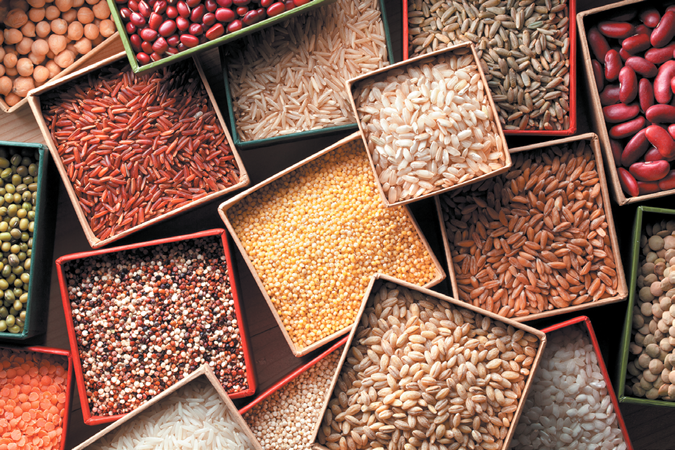Lectins are a group of proteins that bind with carbohydrates. The lectins produced by our bodies perform a large number of functions, including roles in the immune system. Lectins are also found in many of the foods we eat. Nightshade vegetables (like tomatoes, peppers, eggplant, and potatoes), legumes (like beans, chickpeas, lentils, and peanuts), and whole grains are particularly high in dietary lectins.
Potential health effects of dietary lectins have received significant attention from both researchers and proponents of popular diet plans. The Paleo diet, for example, contends that lectins can damage our intestines, leading to inflammation and increased gut permeability. Paleo proponents recommend avoiding consumption of high-lectin foods like whole grains and legumes. “These claims are not consistent with what we know about healthy dietary patterns, rich in whole grains, legumes, nuts, vegetables, and fruits,” says Alice H. Lichtenstein, DSc, director of the Cardiovascular Nutrition Laboratory at the Human Nutrition Research Center on Aging and executive editor of Tufts Health & Nutrition Letter.
Breaking it Down: A closer look at the data behind lectins’ bad reputation can help explain this apparent paradox. First, it’s important to understand that the results of studies done in test tubes cannot always be applied directly to humans. For example, one very old study found that exposing human cells to high levels of a common wheat lectin caused the release of histamines, suggesting lectins are related to food allergies. But no cell in the body would ever be exposed to that quantity of a lectin, particularly the isolated lectins from raw wheat used in the study. The amount of lectins and the form they take once the wheat grain has been processed, cooked, digested, and absorbed is not like the raw form.Similarly, studies in animals cannot be generalized to humans, and, like test tube studies, most animal studies employ exceedingly high doses of isolated lectins. For example, a 2017 study which purported to identify a mechanism by which plant lectins promote inflammation injected lectins into mice at much higher concentrations than one could get from foods.
The Good, The Bad, and the Healthy: “Foods high in lectins are, for the most part, healthy sources of many nutrients, including fiber, vitamins, minerals, and phytochemicals,” says Lichtenstein. “There are no warnings from any governmental or healthcare organization regarding lectin consumption, because the sum of scientific evidence does not warrant concern.” The only exception is lectins in uncooked or undercooked red kidney beans. Consumption of raw kidney beans has been reported to cause nausea, vomiting, and diarrhea in some people, but one can safely consume even large quantities of fully cooked red kidney beans. The U.S. Food and Drug Administration recommends soaking dry red kidney beans for at least five hours and then draining them, adding new water, and boiling them for at least 30 minutes before eating or adding to recipes. (Canned kidney beans have already been properly cooked.)
Some lectins are currently being studied for potential health benefits. For example, wheat germ agglutinin (WGA)—a lectin which has been specifically called out by anti-lectin enthusiasts for its “toxicity” and ability to damage cells—is being looked at as an aid in fighting cancer. While these potential anti-cancer effects have not yet been studied in humans, a recent study in mice found that WGA (at doses that exceed those found in food) killed leukemia cancer cells without damaging normal cells.
Lectin-containing plant foods are packed with health-promoting nutrients. Diets high in these and other plant foods have consistently been associated with health benefits such as lower risk for heart disease, type 2 diabetes, weight gain, and some types of cancer. “The bottom line is foods high in plant lectins are good choices to include in a healthy dietary pattern,” says Lichtenstein.
Lectins get a bad rap, but the foods in which they are found are important components of a healthy dietary pattern and should not be avoided:
-Include whole grains, legumes, nuts, fruits, and vegetables as a regular part of a healthy dietary pattern.
-Soak dry red kidney beans for at least five hours, change water, and boil for 30 minutes before eating (or use canned).

























Thank you. I soakred kidney beans as directed but cook them in a pressure cooker which only takes 15 minutes because of the increased pressure and temperature. I have ever had an ill effect from cooking the this way. What is your opinion? Thank you.
Thank you. I soaked kidney beans as directed but cook them in a pressure cooker which only takes 15 minutes because of the increased pressure and temperature. I have never had an ill effect from cooking them this way. What is your opinion? Thank you.
Makes sense, and it explains why Mom always soaked dried beans overnight before cooking them.
Do you have any comment on the theory that lectins are responsible for “leaky gut” in some people as referred to by Dr. Steve Gundry (gundrymd.com)? And the success he has had with anti-lectin diet in reversing ASHD?
One screwball doctor claims lectins are unhealthy. Consistent with his general ignoranve.